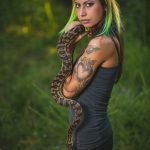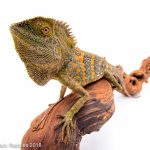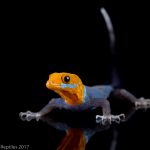What’s the absolute best lens for reptile photography? That’s certainly a very broad question, that will spark a heated debate in any reptile photography enthusiasts’ group. But I’m going to do my best here to recommend some lenses for different situations that you may encounter in studio reptile photography.
If you’re not interested in a big wordy article full of photography mumbo jumbo, or you already know how these things work and you just want to see my list of great lenses for reptile photography, skip past the reptile photography tutorial and go to the end. I’ve compiled a list of links to buy several lenses (from budget up to top of the line) that I’d recommend for reptile photography.
So what’s the best one? These 4 images above were shot with different lenses as they were different circumstances that called for different tools. Starting from the left and working right, these were shot with a telephoto portrait lens, a wide angle landscape lens, a macro lens, and a general use 50mm prime lens.
Which Lens for Which Circumstance?
So first, let’s determine which lenses are good for what situations you may find yourself in.
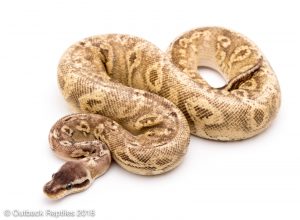
Kit Lens: Great for general multi-purpose use. What’s a kit lens? You most likely have one – Many cameras come with a relatively inexpensive lens along with the body when you buy it as a “kit.” The most common are 18-55mm, 18-135mm, etc. These are relatively cheap, yet still incredibly useful lenses- especially for those just starting out. They have a useful zoom range from wide to short telephoto, lightweight, many have image stabilization built in, and most importantly- the latest versions produce reasonably sharp, good looking images for the price. If you’re using a kit lens, don’t fret- your images will be just fine if you use it right. These lenses do have some limitations (Small maximum aperture, sharpness issues around the edges, long minimum focusing distance, etc). Consider upgrading if you’re at the point where you’re noticing these minor problems in your reptile photography.
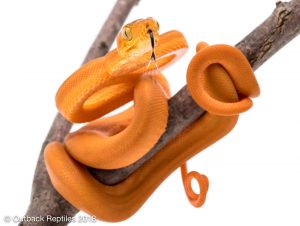 Macro Lenses: Macro lenses, despite the common misconception, are not just for taking pictures of microscopic bugs, etc. I personally use a canon macro lens for most of my studio shots of smaller to medium sized animals. They are great for full body and closeup shots of small to medium snakes, lizards, arachnids, etc. Also good for closeups of bigger animals if you want to accentuate a certain feature, or perhaps show something that isn’t readily apparent (scale patterns, individual claws, etc.) Macro lenses are very sharp and can focus very close (sometimes within an inch or two of the end of the lens itself!) so they are excellent at producing very detailed images. This is why I prefer to use one for most of my stock images and sales ads for baby ball pythons, lizards, geckos, spiders, etc- my customers want the best images possible so they can determine if they want this animal. Limitations: Some macro lenses can be a little slower at focusing, as well as a little bit too tight of a field of view (long focal length) for shots of larger animals. It can be tough to take a photo of a medium sized animal with a 60mm, 90mm, 100mm, etc macro lens as you may have to stand pretty far back to fit it in frame.
Macro Lenses: Macro lenses, despite the common misconception, are not just for taking pictures of microscopic bugs, etc. I personally use a canon macro lens for most of my studio shots of smaller to medium sized animals. They are great for full body and closeup shots of small to medium snakes, lizards, arachnids, etc. Also good for closeups of bigger animals if you want to accentuate a certain feature, or perhaps show something that isn’t readily apparent (scale patterns, individual claws, etc.) Macro lenses are very sharp and can focus very close (sometimes within an inch or two of the end of the lens itself!) so they are excellent at producing very detailed images. This is why I prefer to use one for most of my stock images and sales ads for baby ball pythons, lizards, geckos, spiders, etc- my customers want the best images possible so they can determine if they want this animal. Limitations: Some macro lenses can be a little slower at focusing, as well as a little bit too tight of a field of view (long focal length) for shots of larger animals. It can be tough to take a photo of a medium sized animal with a 60mm, 90mm, 100mm, etc macro lens as you may have to stand pretty far back to fit it in frame.
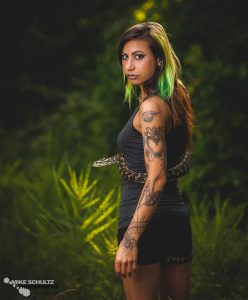 Portrait Lenses: I do occasionally use lenses that are typically considered “portrait” lenses – usually when I’m taking portraits of people with reptiles involved (This is a reptile photography tutorial after all)! Portrait lenses tend to be longer “telephoto” lenses, starting at 50mm and going up to 85, 100, 135, and sometimes up to 200mm. They will also have a wide apertures (f2.8, f2, f1.8, and wider) in order to give you very shallow depth of field to isolate your subject from the background. A long telephoto focal length has the added benefit in that it tends to compress human features a tiny bit, which ends up being a more flattering image. I usually use my Canon 70-200mm f2.8 lens when I am taking outdoor shots of models holding reptiles. One limitation is that you’ll need a lot of room to use these lenses – they are telephoto after all – but if you have the ability to stand a bit further back then you’ll get some excellent results with a portrait lens.
Portrait Lenses: I do occasionally use lenses that are typically considered “portrait” lenses – usually when I’m taking portraits of people with reptiles involved (This is a reptile photography tutorial after all)! Portrait lenses tend to be longer “telephoto” lenses, starting at 50mm and going up to 85, 100, 135, and sometimes up to 200mm. They will also have a wide apertures (f2.8, f2, f1.8, and wider) in order to give you very shallow depth of field to isolate your subject from the background. A long telephoto focal length has the added benefit in that it tends to compress human features a tiny bit, which ends up being a more flattering image. I usually use my Canon 70-200mm f2.8 lens when I am taking outdoor shots of models holding reptiles. One limitation is that you’ll need a lot of room to use these lenses – they are telephoto after all – but if you have the ability to stand a bit further back then you’ll get some excellent results with a portrait lens.
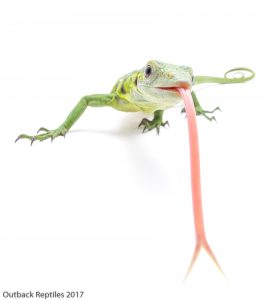
Wide Angle: Great if you want an interesting perspective, or if you want to include some context in your shot. Typically anything below 24mm is considered a wide angle lens, and under 18mm is ultra wide. I don’t use wide angle lenses for reptiles too much, but once in a while I’ll slap my 10mm lens on to mess with the perspective a little bit. Wide angle lenses tend to stretch out the image in interesting ways if used up close as you typically will with reptile photography. As you can see in this Green Tree Monitor shot, his tongue looks absolutely enormous due to this effect. If you’ve ever heard of “forced perspective” in all these images of supposed giant snakes, this is the same effect. The wider the lens, the more distortion it will create, causing subjects closer to the lens to look very large in comparison to things that are further away. The drawback to this is that you are not exactly creating a 100% accurate photo, so for sales ads I tend to stay away from these lenses besides the occasional funny effect it gives.
But this playhouse effect is not the only way to use wide angle lenses for reptile photography. As I stated above, they can also be used to show some context – i.e. what’s around the reptile you’re photographing. This is useful for field herp photography where one may want to show the environment the animal was found in, along with the herp itself.
So which specific lenses would I recommend?
Here’s a basic rundown on some quality lenses that I have either used, or my friends have used and recommended to me for photographing reptiles. Full disclosure- these are affiliate links, which means you pay the same low price you normally would, but the online dealers pay me a small fee for sending you there. Win-Win situation, which means I can continue to provide you with these articles for free.
Macro:
- Good – Canon EF-S 60mm. Great budget macro lens for all canon rebel cameras, 70D, 80D, etc. BUY HERE FOR CANON
- Good – Tamron 90mm. A good third party solution for canon or nikon. BUY HERE FOR CANON | BUY HERE FOR NIKON
- Better – Canon 100mm macro. You wont need to be as close as the 60mm. BUY HERE FOR CANON
- Best – Canon 100mm f2.8 L. The top of the line “L” line with image stabilization. BUY HERE FOR CANON
Portrait:
- Good – “Nifty Fifty” 50mm f1.8. The best lens for the price you will ever buy. BUY HERE FOR CANON | BUY HERE FOR NIKON
- Better – 85mm f1.8 – Many consider this the ultimate budget portrait lens. BUY HERE FOR CANON | BUY HERE FOR NIKON
- Best – 70-200mm f2.8 – Many argue that this is the best, most versatile portrait lens around. BUY HERE FOR CANON | BUY HERE FOR NIKON
- “Budget Best” – Third party versions of the lens above, for cheaper. BUY HERE FOR CANON | BUY HERE FOR NIKON
- Best – 85mm f1.2 L – For canon this is one of the sexiest lenses you can buy. BUY HERE FOR CANON
Wide Angle:
- Good – Canon 10-18mm EF-S. great cheap wide angle lens for rebel cameras, 70d, 80d, etc. BUY HERE FOR CANON
- Best – Laowa 15mm wide angle macro lens. Fully Manual, but my friends swear by this thing. BUY HERE FOR CANON | BUY HERE FOR NIKON
Hopefully I’ve steered you well and you’ll start taking better reptile photos than me. Remember- (even though I just spent an hour explaining all this gear to you) it takes more than just good equipment to take great photos. Happy shooting guys!
-Mike


